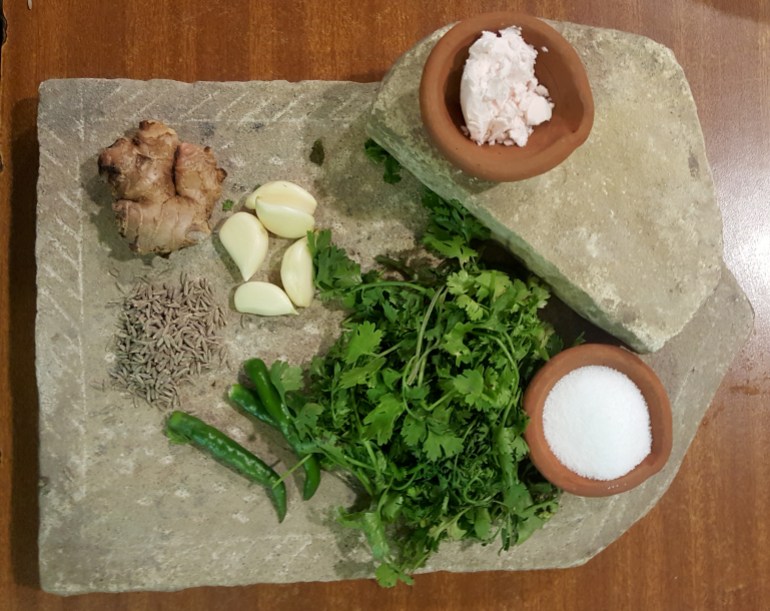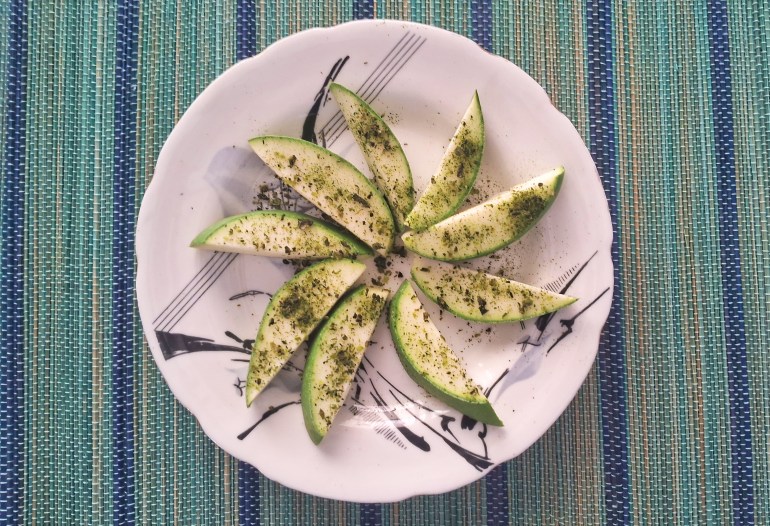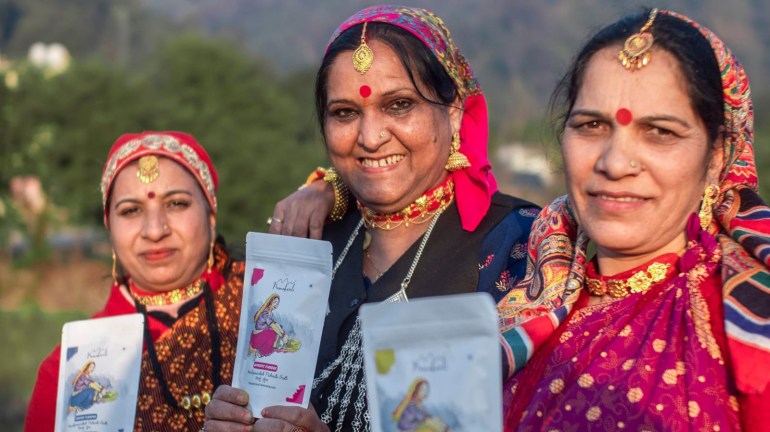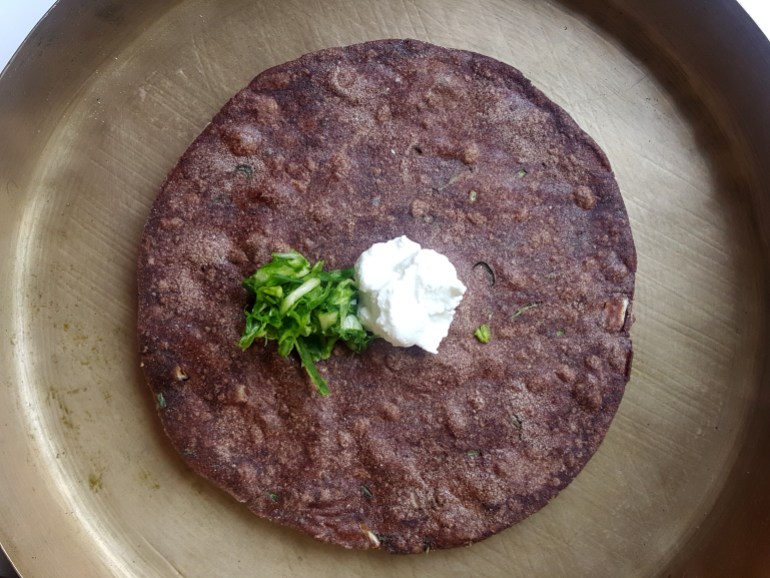[
On the plate in entrance of me, slices of uncooked mango have been neatly organized within the form of flower petals. My good friend Alka Dogra urges me to eat them instantly.
One chunk, and immediately, my style buds gentle up with heat, tangy salt that pairs fantastically with the sourness of the fruit.
“It has the inexperienced chilli pisyun lun (inexperienced chilli salt) from Uttarakhand that you simply needed to style,” she shares.
However I barely hear, already transported again in time. It's lunch time in sixth grade and we’re consuming our method by means of lunch. A lady named Mahima brings a small packet and teasingly asks: “Who desires which?” We bounce with pleasure: It's his mom's distinctive spice mix.
We unfold guavas, apples and oranges. I sprinkle the thick, darkish inexperienced combination on an orange slice and pop it into my mouth. The spicy salt and scorching peppers mix with the candy and bitter orange juice to provide a spicy, tangy taste.
We have been craving that well-known spice combine. And when Mahima left faculty the following 12 months, we needed to sulk and eat fruits with plain salt.
I had virtually forgotten this reminiscence, however 20 years later, I remembered it whereas having fun with some fruits with Alka in Delhi on a sunny winter afternoon. He regretted: “What would have been the purpose if I had taken grandma's grind.”

“Pisune what?” I requested confused.
“That is our particular salt from Uttarakhand,” she replied and promised to share it with me the following time her mom sends some Pisyun Lun.
The wait was value it. As I savored the salt sprinkled mango items saved for me by Alka, I used to be comfortable that there’s now a reputation for the spice combination I beloved a lot as a schoolgirl.

a favourite spice
Pisyun Lun (which interprets to “coarse salt floor with spices”) is a favourite spice in Uttarakhand. On account of its deep reference to native tradition, songs have additionally been written about it. “Hoon Pissu Akela” tells the story of a boy's longing to return to his village for his mom's salt. And “Hai Kakdi Jilema Loon Pisse Sile Ma” is a couple of lady who sees ripe cucumbers and desires of fortunately grinding salt for her fiancé.
Culinary skilled Rushina Munshaw Ghildiyal says that she got here to know that the salty masala is current solely within the kitchens of Uttarakhand. In her documentation of the area's delicacies, which she has been compiling for 25 years in efforts to seize the recipes – her husband is initially from the area – she has recorded greater than 17 kinds of flavored salts, every of which ” Claims to have “well being and medicinal properties.”
“Each prepare dinner and family on this area has its personal variations based mostly on private and household preferences,” she says, including that she is trying to publish a cookbook subsequent 12 months.
Residence chef Nitika Kuthiyala, who specializes within the delicacies of the neighboring state of Himachal, says: “That is just like the Indian quintessential garam masala (day by day spice combine) recipe that each household has and is ready with no matter is accessible. Is.”
Individuals who grew up with spices typically have fond recollections of their childhood. Nandini Jayal Khanduri, a jewelery designer from the state capital Dehradun, remembers dashing dwelling from faculty every single day to see her mom sitting within the winter solar making khatai with neighbours.
The combination, which is a regional favorite, is ready from chakotra (grapefruit), malta (blood orange) and galgal (mountain lemon). The fruit is peeled and pulped earlier than being blended with salt and spices. Typically roasted sesame powder can also be added to scale back the sourness. It’s typically loved with parathas or flatbreads. “Even speaking about sourness makes my mouth water,” laughs Khanduri.
Kavita Manralm spent her childhood in Ranikhet the place her father, a military officer, was posted. She remembers having fun with lemon with inexperienced chilli garlic pisyun loon within the yard – her favorite. As an grownup, she makes this salt in her dwelling in Ghaziabad.

salty historical past
As a result of salt is an important factor for important physique features, and people additionally crave it, traditionally it has been used as foreign money, nevertheless it has additionally been closely taxed and even It has additionally been the middle of conflicts such because the Battle of Ferrara (1482–1484). Venice and Ferrara and the Salt Warfare (1556–1557) between Naples and the Papal States. The well-known Dandi March led by Mahatma Gandhi in 1930, also referred to as the Salt March, was a big occasion throughout India's wrestle for independence from British rule. It was a non-violent protest in opposition to the salt tax imposed by the British, which gave the British authorities a monopoly on salt manufacturing and distribution, making it unlawful for Indians to gather or promote salt.
The indispensability and price of salt made it beneficial, forcing individuals to hunt extra of it – Ghildiyal A wild salt leaf utilized by the tribal communities of the Sahyadri area in western India and by the tribal group in Australia. Cue salt scrub for use – and use it sparingly.
On account of its power, salt can be utilized in small portions to make pickles, chutneys and lun (salt), permitting it to be “unfold”, says Ghildiyal.
That's why “this salt custom developed in each Svaneti, Georgia, and Uttarakhand, India, two mountainous locations the place salt needed to be transported over tough terrain,” explains Canadian cookbook creator Naomi Duguid, who wrote The Pleasure of Salt. Are. Duguid explains that in Quebec, Canada, a salt combination referred to as “herbs cells” is made with finely chopped recent inexperienced herbs and shredded carrots, then saved in jars and used as seasoning for quite a lot of dishes. Is used as.
The origins of the Pisyun Lun stay considerably of a thriller. Nevertheless, Ghildiyal has a principle: The Bhutia group, which spans Tibet and three Indian states bordering Nepal (Sikkim, West Bengal and Uttarakhand), traditionally traded herbs and spices with one another. Had been. Since salt was offered in rocks or blocks, it wanted to be floor with a silbatta (millstone) – spices additionally wanted to be floor. Ghildiyal believes that this led to the unintended creation of flavored salt. “Somebody could have used a mortar and pestle to crush salt that was beforehand used to grind one thing else and located that the spice left on the stone enhanced its taste.”
Chef Tanaya Joshi from Uttarakhand says lack of recent greens throughout winter – particularly within the mountains – may be a motive, prompting individuals to discover new methods of making ready meals.

making ready flavored salt
Ghildiyal factors out that there isn’t any documentation of recipes, variations or mixtures of those salts. Household recipes, that are “handed down largely by great-grandmothers and grandmothers”, are rooted within the availability of components, private preferences and “the philosophy of the pinnacle prepare dinner of the home” – even the medicinal properties of the components. Thus, the combo varies from family to family and area to area.
That is additionally the case with Svanuri marili or Svan salt, the flavored salt of Svaneti, Dugid notes, which generally contains dill, fenugreek, marigold petals, coriander, oregano, dried pink pepper and many garlic. It may be utilized in meat marinades or rubs, as a seasoning throughout cooking, or as a spice.
For pisyun loon, dry spices like asafoetida (fennel), basil, celery, mint, coriander or inexperienced chillies are added to white, pink and rock salt (sendha namak), says Kuthiala. Contemporary coriander, which isn’t at all times accessible within the area, is used throughout the season. “The principle ingredient is salt, and you may add something you want.”
Joshi says, salts created from Bhang (hemp seeds), Jakhya (wild mustard) and Bhang cumin are fairly well-liked within the Kumaon area.
Inexperienced garlic salt is a winter specialty in Uttarakhand. Other than this, on this season iodine, pink and rock salt are blended with amchur (dry mango powder) and sprinkled on oranges, guavas and papayas. In summer time, mint salt and chilli cumin salt are very fashionable, and varied salts are added to dahi raita (curd blended with tomato, onion or cucumber) and mathha (stirred buttermilk).
Throughout each seasons, the combination is unfold on paper and dried within the shade – by no means within the solar – to protect its flavour; Nevertheless, Kuthiyala factors out that it’s eaten recent throughout monsoon. After drying, the combination seems to be like grains of salt. The household typically types seven or eight varieties; The shelf life of 1 batch is about two years.
In relation to consuming pisyun loon, choices abound. It may be sprinkled on vegetables and fruit, cooked into dishes, blended with rice and ghee, and added to ramen or immediate noodles.
Joshi remembers consuming ragi roti smeared with ghee and consuming pisyun loon. Spreading savory salt on bread is a well-liked lunch choice—it ages properly and doesn't require refrigeration.

Inexperienced garlic, salt and sugar are sometimes served with jhangora (barnyard millet), cooked in buttermilk, making a porridge referred to as paleu or chencha, which is eaten at breakfast. The flavored salt used on this porridge varies with the season: for instance, inexperienced garlic salt (Inexperienced Garlic Salt) in winter and cumin salt (Jeera Namak) in summer time.
Discovering Worldwide Followers
On account of its growing recognition in different areas of India and overseas, Pisyun Loon is now being offered by means of social media and on-line purchasing platforms.
Shashi Raturi has been working an NGO (Mahila Nav Jagran Samiti) in Dehradun since 1982, which helps ladies discover employment. “We might have lunch collectively and all these ladies would purchase selfmade salt,” she says. This gave her the concept of promoting pisyun loon to generate earnings and employment.
Raturi started promoting flavored salts beneath the Namakwali (“salt ladies”) label in 2015 – they’re now accessible on Amazon. “We use Garewal salt (rock salt), not industrial salt, and the combination is made by hand utilizing a pestle and mortar,” she says. It takes about three to 4 days to provide a batch of 10 kg (22 lb) of flavored salt.

Deepa Devi of Kakrighat village close to Almora has been promoting flavored salt since 2011. Beginning on a small scale from a store on the primary street, he ready quite a lot of mixtures with chillies and offered about 5,000 rupees ($60) value of salt. Within the first two years.
Right now, working with a crew of 9 ladies and taking orders by means of WhatsApp, she sells greater than 20 dishes created from chillies, native spices and herbs like timur, ginger, inexperienced garlic, cumin, asafoetida, sesame seeds and others. Varieties promote. She has educated round 500 ladies and set them up in their very own impartial companies.
Ghildiyal says she has not discovered such a convention of creating flavored salt wherever else in India, and he or she desires to maintain the custom alive. She has been given jars of ghar ka namak (selfmade salt) by householders throughout her culinary keep in Uttarakhand, and he or she can also be creating a few of her personal flavours, resembling Stinging Nettle.
Our ancestors had discovered how you can use salt judiciously to outlive in seasons of famine, harsh locations, and shortage, says Dugaid. “Salt have to be revered and honored.”
The flavored salts of Uttarakhand are extra than simply spices. They have fun relationships, create recollections, encourage tales and songs, and bear in mind the beloved individuals who created them: grandmothers, moms, sisters, and wives.

